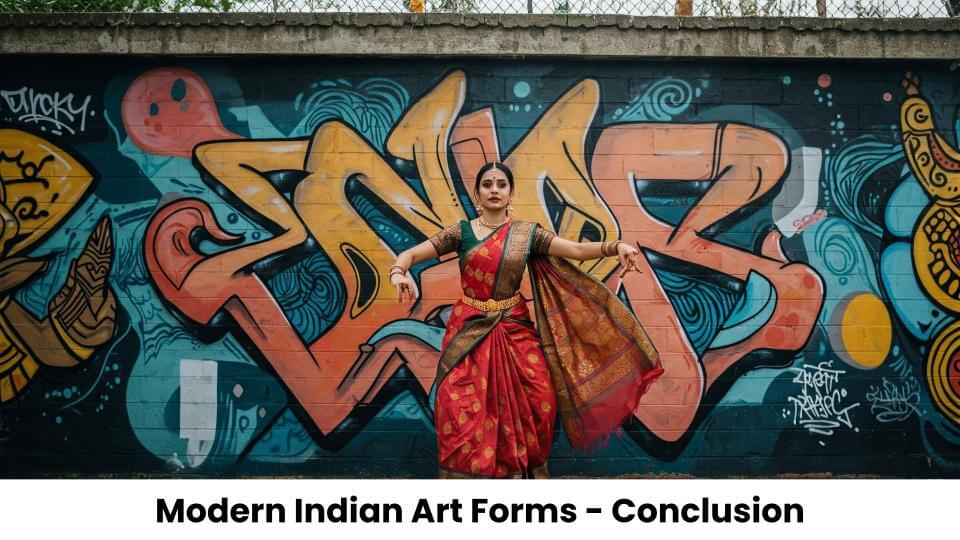Explore the rich heritage of Ancient Indian Literature, a treasure trove of wisdom, philosophy, and storytelling. From the sacred Vedas, Upanishads, and Puranas to epics like the Ramayana and Mahabharata, India’s literary legacy spans millennia. Sanskrit texts, Buddhist and Jain scriptures, and classical Tamil works such as Sangam poetry offer profound insights into life, dharma, and spirituality. Ancient scholars like Valmiki, Vyasa, Kalidasa, and Chanakya shaped literature, influencing generations. Delve into the beauty of poetic verses, philosophical discourses, and timeless moral tales that continue to inspire and guide humanity. Unravel the essence of India’s literary past today!
Modern Indian Art Forms – Conclusion
Introduction
Indian art has undergone a transformative journey over the past century, merging traditional aesthetics with contemporary influences. From the bold strokes of the Progressive Artists’ Group in the 1940s to the digital experiments of the 21st century, modern Indian art has continuously evolved. As we conclude our exploration of modern Indian art forms, it is essential to reflect on their impact, future possibilities, and how they continue to shape India’s artistic identity on the global stage.
A Synthesis of Tradition and Innovation
One of the most striking aspects of modern Indian art is the seamless blend of tradition and innovation. Artists have skillfully merged indigenous techniques with global artistic trends, ensuring that Indian art remains dynamic and relevant. For instance, the works of S.H. Raza, M.F. Husain, and Tyeb Mehta have drawn from both Indian folk traditions and Western modernist movements. This synthesis allows for a unique representation of India’s cultural diversity and historical depth.
The emergence of contemporary artists like Subodh Gupta and Bharti Kher highlights how traditional motifs can be reimagined using unconventional materials. Gupta’s installations, which use everyday objects like kitchen utensils, redefine Indian domestic life within a globalized context. Similarly, Kher’s use of bindis as an artistic medium speaks to the evolving role of cultural symbols in modern narratives.
The Influence of Globalization
Globalization has played a crucial role in shaping modern Indian art. With increased access to international platforms, Indian artists have gained recognition beyond national borders. Major international exhibitions, biennales, and auctions have provided exposure to Indian art, allowing it to be appreciated in diverse cultural contexts.
Moreover, the cross-cultural exchange facilitated by globalization has enriched the artistic vocabulary of Indian artists. Contemporary painters, sculptors, and digital artists draw inspiration from global movements such as abstract expressionism, minimalism, and pop art, blending these with indigenous themes to create unique visual languages.
Digital Art and New Media
The advent of technology has significantly influenced modern Indian art, leading to the rise of digital art and new media. Digital painting, graphic design, and NFT (Non-Fungible Token) art have gained traction among contemporary Indian artists. Platforms like Instagram, Behance, and OpenSea have enabled artists to showcase their work globally without relying solely on traditional galleries.
Indian digital artists such as Harshit Agrawal, who works with artificial intelligence, and Raghava KK, who explores interactive storytelling, are pushing the boundaries of artistic expression. These innovations highlight how Indian art is not only adapting to technological advancements but also setting new creative standards in the digital age.
The Role of Art Institutions and Collectors
Art institutions and collectors have played a pivotal role in preserving and promoting modern Indian art. Organizations like the National Gallery of Modern Art (NGMA), the Kochi-Muziris Biennale, and the India Art Fair have provided platforms for emerging and established artists to showcase their work.
Private collectors and auction houses such as Sotheby’s and Christie’s have further boosted the visibility of Indian art on the global stage. The increasing valuation of Indian artworks in international markets signifies a growing appreciation for the country’s modern artistic contributions.
The Social and Political Impact of Modern Art
Modern Indian art has not only been a medium of aesthetic expression but also a powerful tool for social and political commentary. Many contemporary artists use their work to address pressing issues such as gender inequality, environmental degradation, and political unrest.
For instance, the works of Nalini Malani and Sudarshan Shetty engage with themes of feminism, mythology, and existentialism, challenging viewers to reconsider societal norms. Similarly, street artists and muralists like Daku and Guesswho use urban spaces as canvases to comment on social realities, making art more accessible to the public.
Challenges and Future Directions
Despite its remarkable growth, modern Indian art faces several challenges. One of the primary concerns is the need for more robust infrastructure to support artists, including funding, exhibition spaces, and educational institutions. While major cities like Mumbai and Delhi have thriving art scenes, smaller towns and rural areas still lack adequate resources for artistic development.
Furthermore, the commercialization of art poses a challenge to artistic integrity. With the rise of art auctions and speculative investments, there is a risk that art may be produced primarily for marketability rather than genuine creative expression.
Looking ahead, the future of modern Indian art lies in its ability to remain adaptive and innovative. Encouraging collaborations between traditional artisans and contemporary artists, integrating art into public spaces, and leveraging technology for wider accessibility will be crucial in shaping the next phase of Indian art.
Conclusion
Modern Indian art stands at a fascinating crossroads, where tradition meets contemporary experimentation, and local narratives find resonance on global platforms. The journey of Indian art from its post-independence struggles to its present-day vibrancy reflects the country’s evolving cultural and social landscape.
As artists continue to push creative boundaries, modern Indian art will remain a vital force in shaping India’s cultural identity. By embracing both its historical roots and the possibilities of the future, Indian art ensures its relevance in an ever-changing world. Whether through canvas, sculpture, digital screens, or urban walls, the spirit of Indian creativity continues to inspire and redefine artistic expression for generations to come.
